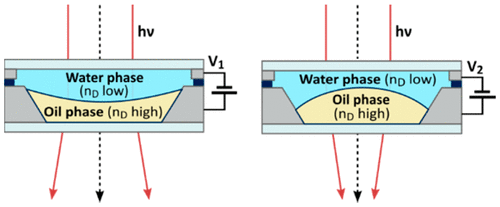当前位置:
X-MOL 学术
›
ACS Comb. Sci.
›
论文详情
Our official English website, www.x-mol.net, welcomes your feedback! (Note: you will need to create a separate account there.)
Development of Biphasic Formulations for Use in Electrowetting-Based Liquid Lenses with a High Refractive Index Difference
ACS Combinatorial Science ( IF 3.903 ) Pub Date : 2018-07-16 00:00:00 , DOI: 10.1021/acscombsci.8b00042 Matthias S. Ober 1 , Daniel Dermody 1 , Mathieu Maillard 2 , Franck Amiot 2 , Géraldine Malet 2 , Benjamin Burger 2 , Caroline Woelfle-Gupta 1 , Bruno Berge 2
ACS Combinatorial Science ( IF 3.903 ) Pub Date : 2018-07-16 00:00:00 , DOI: 10.1021/acscombsci.8b00042 Matthias S. Ober 1 , Daniel Dermody 1 , Mathieu Maillard 2 , Franck Amiot 2 , Géraldine Malet 2 , Benjamin Burger 2 , Caroline Woelfle-Gupta 1 , Bruno Berge 2
Affiliation

|
Commercial electrowetting-based liquid lenses are optical devices containing two immiscible liquids as an optical medium. The first phase is a droplet of a high refractive index oil phase placed in a ring-shaped chassis. The second phase is electrically conductive and has a similar density over a wide temperature range. Droplet curvature and refractive index difference of two liquids determine the optical strength of the lens. Liquid lenses take advantage of the electrowetting effect, which induces a change of the interface’s curvature by applying a voltage, thereby providing a variable focal that is useful in autofocus applications. The first generation of lens modules were highly reliable, but the optical strength and application scope was limited by a low refractive index difference between the oil and conductive phase. Described herein is an effort to increase the refractive index difference between both phases, while maintaining other critical application characteristics of the liquids, including a low freezing point, viscosity, phase miscibility, and turbidity after thermal shock. An important challenge was the requirement that both phases have to have matching densities and hence had to be optimized simultaneously. Using high throughput experimentation in conjunction with statistical design of experiments (DOE), we have developed a series of empirical models to predict multiple physicochemical properties of both phases and derived ideal locations within the formulation space. This approach enabled the development of reliable liquid lenses with a previously unavailable refractive index difference of ΔnD of ≥0.290, which enabled true optical zooming capability.
中文翻译:

用于具有高折射率差的电润湿基液体透镜的双相配方的开发
商用基于电润湿的液体透镜是一种光学设备,其中包含两种不混溶的液体作为光学介质。第一相是放置在环形底座中的高折射率油相的液滴。第二相是导电的,并且在很宽的温度范围内具有相似的密度。两种液体的液滴曲率和折射率差决定了镜片的光学强度。液体透镜利用了电润湿效应,该效应通过施加电压来引起界面曲率的变化,从而提供可用于自动聚焦应用中的可变焦点。第一代镜头模块非常可靠,但光学强度和应用范围受到油相和导电相之间低折射率差的限制。本文描述了在保持液体的其他关键应用特性(包括低凝固点,粘度,相混溶性和热冲击后的浊度)的同时努力增加两相之间的折射率差的努力。一个重要的挑战是要求两个相必须具有匹配的密度,因此必须同时进行优化。使用高通量实验和实验统计设计(DOE),我们开发了一系列经验模型来预测两个相的多种理化特性以及在配方空间中推导出的理想位置。这种方法可以开发出可靠的液体透镜,其先前没有折射率差ΔÑ d的≥0.290,这使真正的光学变焦能力。
更新日期:2018-07-16
中文翻译:

用于具有高折射率差的电润湿基液体透镜的双相配方的开发
商用基于电润湿的液体透镜是一种光学设备,其中包含两种不混溶的液体作为光学介质。第一相是放置在环形底座中的高折射率油相的液滴。第二相是导电的,并且在很宽的温度范围内具有相似的密度。两种液体的液滴曲率和折射率差决定了镜片的光学强度。液体透镜利用了电润湿效应,该效应通过施加电压来引起界面曲率的变化,从而提供可用于自动聚焦应用中的可变焦点。第一代镜头模块非常可靠,但光学强度和应用范围受到油相和导电相之间低折射率差的限制。本文描述了在保持液体的其他关键应用特性(包括低凝固点,粘度,相混溶性和热冲击后的浊度)的同时努力增加两相之间的折射率差的努力。一个重要的挑战是要求两个相必须具有匹配的密度,因此必须同时进行优化。使用高通量实验和实验统计设计(DOE),我们开发了一系列经验模型来预测两个相的多种理化特性以及在配方空间中推导出的理想位置。这种方法可以开发出可靠的液体透镜,其先前没有折射率差ΔÑ d的≥0.290,这使真正的光学变焦能力。



























 京公网安备 11010802027423号
京公网安备 11010802027423号